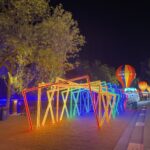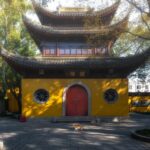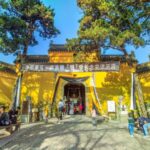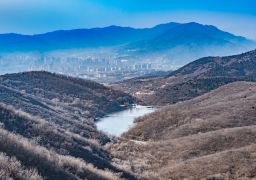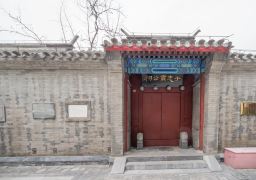Couple’s Garden, originally named Sheyuan, was restored to its current layout by Shen Bingcheng during the Tongzhi era of the Qing Dynasty, and was renamed Couple’s Garden. The name refers to the central residential area, flanked by two gardens on the east and west, resembling a lotus root, and also symbolizes the ‘perfect couple’ he found in the talented lady, Yan Yonghua, with whom he lived in seclusion for eight years in the garden.
Couple’s Garden is an ideal place for couples and also suitable for visitors who wish to quietly appreciate the charm of Suzhou gardens, as it lacks the hustle and bustle of the Humble Administrator’s Garden and the Lion Grove. Entering the garden through a modest door, one arrives at the central residential area, which stretches from south to north and includes the entrance hall, sedan chair hall, Zaijiu Hall (the main hall), and the upstairs hall. The brick-carved gateway in front of the upstairs hall, inscribed with ‘Poetry and Wine Unite in Joy,’ is exquisite and hosts Suzhou Pingtan performances. Audience members can request different songs, each with a varying price. The Eastern Garden is the essence of Couple’s Garden, with two main attractions. First, the robust yellow stone rockeries, with the main mountain on the east side named Liuyunxu, and the sheer cliff on the east side of the mountain plunging into the Shouyue Pool. On the west side, there is a smaller mountain called Taoyu, with a gorge-like ‘Sui Gu’ between the two mountains. Walking through it, one feels the steep cliffs on both sides, and there are stone steps leading up the mountain, incorporating the topography of famous mountains and rivers into this small garden, making the artificial mountains appear as real as natural ones. Second, the杞梓 wood ‘Three Friends in Winter’ floor screen in the southern part of the landscape resembles a door frame, with exquisite hollow-out wood carvings, said to be a relic from the Ming Dynasty. The main hall of the Eastern Garden, Chengqu Caotang, is located in the north, with long corridors embracing it on both sides. The Xilang corridor extends southward, passing by Yan Yonghua’s study, Wusu Yunxuan, which has a couplet she wrote: ‘Couple’s Garden hosts the perfect couple, Chengqu builds the city of poetry,’ with the horizontal inscription ‘Pillow Waves and Double Seclusion,’ a very famous couplet in Couple’s Garden that expresses the love between husband and wife. In the Junlang corridor to the east, there is a half-kiosk with a ‘Lunyuan Tu’ stele on the kiosk wall, which is the work of a famous artist from the early Qing Dynasty, Wang Wenzhi, and also bears the autographs of the Shen couple, making it very precious. The Wu’ai Pavilion to the east of the garden is where Yan Yonghua played the zither, and next to it is the Tingqin Xuan where Shen Bingcheng listened to her play. The garden is filled with subtle details that reflect the simple and enduring love between the two, which are worth exploring. The main hall of the Western Garden, Zhilian Laowu, is a study, with the collection of books to the north, and the Heshou Pavilion to the east, built against the wall, with beautiful brick-carved flower windows on the corridor walls. To the south, there is a rockeries, corresponding to the yellow stone rockeries in the Eastern Garden. The Western Garden is small but exquisite, indeed a good place for the owner to read. Couple’s Garden is surrounded by rivers on three sides and opens to the street on one side. Northwest of Chengqu Caotang, the cruise ship dock extends beyond the garden’s walls, and having a private dock is another distinctive feature of Couple’s Garden. You can board a hand-oared boat that travels along the high walls of the garden to the moat’s green belt, where you can also see a section of the new city wall.Cou Garden and Surrounding Attractions
Cou Garden is a relatively small site that can be easily explored, making it ideal to visit in conjunction with nearby attractions. Don’t miss the unassuming Double Well Hundred Springs at the intersection of Cang Street and Da Xin Qiao Lane outside the garden. To the south, you can visit the Xiangmen City Gate and Soochow University. To the north, the adjacent East Garden, essentially an urban park, can be visited together. To the west, you can explore the hidden mini-garden, Bei Ban Yuan, stroll through the historical district of Pingjiang Road, and enjoy local cuisine on Guanqian Street. To the northwest, there are the Lion Grove Garden and the Humble Administrator’s Garden, approximately 1.5 to 2 kilometers away. Opening Hours From March 1st to October 31st, the garden is open from 07:30 to 17:30; from November 1st to February 28th, it is open from 07:30 to 17:00. Preferential Policies Children: Children aged 6 (inclusive) or under 1.4 meters (inclusive) in height enter for free when accompanied by an adult. Minors between 6 (exclusive) and 18 (inclusive) years old enjoy half-price admission. Elders: Elders aged 70 (inclusive) and above from across the country can enter for free with a Senior Citizen Certificate or a resident ID card. Those aged between 60 (inclusive) and 69 (inclusive) can enjoy half-price admission with a valid resident ID card and a Senior Citizen Preference Certificate. Students: Full-time undergraduate and below students can enjoy half-price admission with a valid ID card or student certificate. Military Personnel: Active military personnel and disabled veterans enter for free with a military ID and a disabled veteran’s certificate. Retired military officers and retired military cadres enter for free with a retirement certificate. Disabled Persons: People with disabilities from across the country can enter for free with a valid Disability Certificate. Severely disabled individuals can have one free accompanying person enter the garden. Blood Donors: Individuals who have won national awards for unpaid blood donation, unpaid donation of hematopoietic stem cells, and lifelong honors for unpaid blood donation service can enter for free with relevant certificates. Fire and Rescue Personnel: On-duty, retired, and disabled fire and rescue personnel, as well as students from fire and rescue academies, can enter for free with valid certificates. Preferential Treatment Recipients: Recipients with the ‘People’s Republic of China Veterans’ Preference Certificate’ and ‘People’s Republic of China Martyrs, Military Personnel Who Died in the Line of Duty, and Deceased Military Personnel’s Dependents’ Preference Certificate’ enter for free (excluding garden within the garden, in-park charges, and night tours). Medical Staff in Suzhou: Medical staff in Suzhou can visit the scenic area for free from International Nurses Day on May 12th and Chinese Doctors’ Day on August 19th for seven days (May 12th to 18th, August 19th to 25th). When visiting the scenic area, medical staff in Suzhou should present their ‘Personal ID’ + ‘Suzhou Medical Staff Free Gardening Card (electronic card)’ and can enter without an appointment, with the first admission ticket fee waived.Free service facilities. Parking lot: [Dongyuan Parking Lot]. Reference price: Free. Address: No. 6, Xiaoxin Bridge Lane, Cang Street, Gusu District, Suzhou City. Number of parking spaces: 50.
